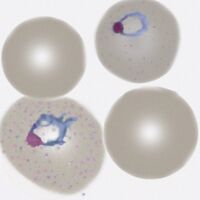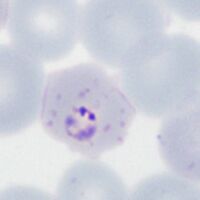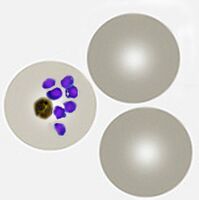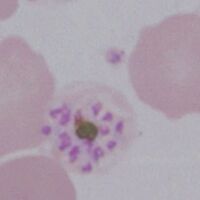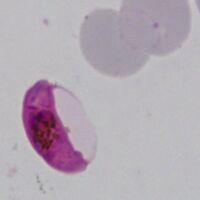Plasmodium vivax: Morphology: Difference between revisions
From haematologyetc.co.uk
(Created page with ". distribution p.vivax is generally considered a parasite of central and south america india and s.e.asia. the low frequency of the duffy antigen that facilitates the entry of p.vivax into erythrocytes means that this malaria species has lower frequency in africa. aside from this however plasmodium vivax infection occurs across the widest geographic area of all the human malarias extending well into temperate climates. this behaviour is enabled by the dormant stag...") |
No edit summary |
||
| Line 1: | Line 1: | ||
. | ---- | ||
'''Navigation'''</br> | |||
<span style="font-size:80%">(click blue highlighted text to return to page)</span></br></br> | |||
<span style="font-size:90%">[[Malaria Index|Malaria main index]]</span></br> | |||
<span style="font-size:90%">>[[Species identification: summary page]]</span></br> | |||
<span style="font-size:90%">>>This page: <u>''P.falciparum'': morphology</u></span> | |||
---- | |||
{| class="wikitable" style="border-style: solid; border-width: 5px; border-color: #023020; color:black" | |||
|colspan="1" style = "font-size:100%; color:black; background: CBD5CO |'''The early trophozoite''' | |||
|} | |||
<gallery mode="nolines" widths=200px heights=200px> | |||
File:PVETc.jpg|link={{filepath:PVETc.jpg}} | |||
File:PVET-main image.jpg|link={{filepath:PVET-main_image.jpg}} | |||
</gallery> | |||
<br clear=all> | |||
The earliest ring forms may be indistinguishable from other species, but during this stage the parasite tends to aquire a more irregular forms and to show signs of modification of the erythrocyte (added dots, and altered size and shape). | |||
*erythrocytes begin to increase size and may become distorted in shape | |||
*parasites retain a ring form but may aquire a more irregular frm | |||
*parasites are generally large - occupying up to half of the erythrocyte | |||
*cytoplasmic Schuffners dots may appear at this stage, although pigment uncommon | |||
<div style="width: 350px"> | |||
{| class="wikitable" style="border-left:solid 4px navy;border-right:solid 4px navy;border-top:solid 4px navy;border-bottom:solid 4px navy; font-size:90%; color:navy; align:center" | |||
| colspan="1"''|[[P.vivax early trophozoites gallery|Click for ''P.vivax'' early trophozoite gallery]]'' | |||
|} | |||
</div> | |||
---- | |||
{| class="wikitable" style="border-style: solid; border-width: 5px; border-color: #023020; color:black" | |||
|colspan="1" style = "font-size:100%; color:black; background: CBD5CO |'''The late trophozoite''' | |||
|} | |||
<gallery mode="nolines" widths=200px heights=200px> | |||
File:PFLTc.jpg|link={{filepath:PFLTc.jpg}} | |||
File:PFLT-main image.jpg|link={{filepath:PFLT-main_image.jpg}} | |||
</gallery> | |||
<br clear=all> | |||
The later growth stage: | |||
*Parasites resemble early ring forms, but are thicker and may be slightly larger | |||
*Additional blue/grey dots and clefts are seen in red cell cytoplasm when [[stained correctly]] | |||
*These dots have low number a characteristic "dot" or "line" form [[Maurer's dots and clefts]] | |||
*[[Red cell size and shape|Size and shape]] of infected red cells is usually unaffected, but may become crenated | |||
*The [[Double chromatin dot forms|double dot]], [[Accolé form| accolé]], and [[multiple parasites|multiple parasite]] forms remain present | |||
<div style="width: 350px"> | |||
{| class="wikitable" style="border-left:solid 4px navy;border-right:solid 4px navy;border-top:solid 4px navy;border-bottom:solid 4px navy; font-size:90%; color:navy; align:center" | |||
| colspan="1"''|[[P.falciparum late trophozoites gallery|Click for ''P.falciparum'' late trophozoite gallery]]'' | |||
|} | |||
</div> | |||
---- | |||
{| class="wikitable" style="border-style: solid; border-width: 5px; border-color: #023020; color:black" | |||
|colspan="1" style = "font-size:100%; color:black; background: CBD5CO |'''The schizont''' | |||
|} | |||
<gallery mode="nolines" widths=200px heights=200px> | |||
File:PFSc.jpg|link={{filepath:PFSc.jpg}} | |||
File:PFS-main image 2.jpg|link={{filepath:PFS-main_image 2.jpg}} | |||
</gallery> | |||
<br clear=all> | |||
The asexual form: | |||
*'''Do not generally circulate in this species unless overwhelming infection''' | |||
*The asexually formed developing "merozoites" cluster untidily | |||
*[[Schizont Development|Schizonts]] develop progressively to form 8-16 merozoites when mature | |||
*In this species the loose [[Malaria pigment|malaria pigment]] may be seen in clumps between the parasites | |||
*Red cell size is generally unaffected but red cells become pale as haemoglobin is metabolised by the parasites | |||
<div style="width: 350px"> | |||
{| class="wikitable" style="border-left:solid 4px navy;border-right:solid 4px navy;border-top:solid 4px navy;border-bottom:solid 4px navy; font-size:90%; color:navy; align:center" | |||
| colspan="1"''|[[P.falciparum schizont gallery|Click for ''P.falciparum'' schizont gallery]]'' | |||
|} | |||
</div> | |||
---- | |||
'''The gametocyte''' | |||
{| class="wikitable" style="border-style: solid; border-width: 5px; border-color: #023020; color:black" | |||
|colspan="1" style = "font-size:100%; color:black; background: CBD5CO |'''The gametocyte''' | |||
|} | |||
<gallery mode="nolines" widths=200px heights=200px> | |||
File:PFGc.jpg|link={{filepath:PFGc.jpg}} | |||
File:PFG-main image.jpg|link={{filepath:PFG-main_image.jpg}} | |||
</gallery> | |||
<br clear=all> | |||
The sexual replication form (very distinctive). | |||
*Gametocytes are elongated but are restricted into typical shape by the red cell membrane | |||
*They parasites are rod shaped but the membrane may cause them to curve into a “[[Banana gametocyte|"banana" form]]” | |||
*The residual membrane (empty of haemoglobin) is often seen as a "blister" to the side of the parasite | |||
*The single chromatin area is in the centre of the parasite, often has [[Malaria pigment|pigment]] overlying it | |||
*Gametocytes may not be be seen, or may be the only form present (particularly after treatment) | |||
<div style="width: 350px"> | |||
{| class="wikitable" style="border-left:solid 4px navy;border-right:solid 4px navy;border-top:solid 4px navy;border-bottom:solid 4px navy; font-size:90%; color:navy; align:center" | |||
| colspan="1"''|[[P.falciparum gametocyte gallery|Click for ''P.falciparum'' gametocyte gallery]]'' | |||
|} | |||
</div> | |||
---- | |||
*erythrocytes begin to increase size and shape of infected red cells enlarged and distorted during this stage *parasites have a ring form this may be quite irregular *parasites are generally large - occupying up to half of the erythrocyte *cytoplasmic schu8c3bcffneru8e28099s dots may appear at this stage but malaria pigment is not usually seen | |||
the late trophozoite file pvlt.jpg leftt 200px link filepath pvlt.jpg *infected erythrocytes are clearly significantly enlarged and lose their regular outline *parasites are noticeably irregular becoming amoeboid in form *numerous purple schu8c3bcffneru8e28099s dots are seen in the cytoplasm *pigment is often present with irregular distribution | |||
the schizont file pvs.jpg leftt 200px link filepath pvs.jpg *a range of maturing schizonts will generally be present within enlarged red cells *mature schizonts generally contain 16-24 separate merozoites *schu8c3bcffneru8e28099s dots can be detected in any residual cytoplasm of the erythrocyte *pigment is visible in irregularly distributed clumps over the schizont surface | |||
the gametocyte file pvg.jpg leftt 200px link filepath pvg.jpg *very large with ovoid or distorted forms *macrogametocytes female may entirely fill the erythrocyte *microgametocytes male may have a thin cytoplasmic rim with visible schu8c3bcffneru8e28099s dots *pigment is clumped over the surface of the gametocyte | |||
Revision as of 09:46, 2 April 2024
Navigation
(click blue highlighted text to return to page)
Malaria main index
>Species identification: summary page
>>This page: P.falciparum: morphology
| The early trophozoite |
- PVET-main image.jpg
The earliest ring forms may be indistinguishable from other species, but during this stage the parasite tends to aquire a more irregular forms and to show signs of modification of the erythrocyte (added dots, and altered size and shape).
- erythrocytes begin to increase size and may become distorted in shape
- parasites retain a ring form but may aquire a more irregular frm
- parasites are generally large - occupying up to half of the erythrocyte
- cytoplasmic Schuffners dots may appear at this stage, although pigment uncommon
| The late trophozoite |
The later growth stage:
- Parasites resemble early ring forms, but are thicker and may be slightly larger
- Additional blue/grey dots and clefts are seen in red cell cytoplasm when stained correctly
- These dots have low number a characteristic "dot" or "line" form Maurer's dots and clefts
- Size and shape of infected red cells is usually unaffected, but may become crenated
- The double dot, accolé, and multiple parasite forms remain present
| The schizont |
The asexual form:
- Do not generally circulate in this species unless overwhelming infection
- The asexually formed developing "merozoites" cluster untidily
- Schizonts develop progressively to form 8-16 merozoites when mature
- In this species the loose malaria pigment may be seen in clumps between the parasites
- Red cell size is generally unaffected but red cells become pale as haemoglobin is metabolised by the parasites
The gametocyte
| The gametocyte |
The sexual replication form (very distinctive).
- Gametocytes are elongated but are restricted into typical shape by the red cell membrane
- They parasites are rod shaped but the membrane may cause them to curve into a “"banana" form”
- The residual membrane (empty of haemoglobin) is often seen as a "blister" to the side of the parasite
- The single chromatin area is in the centre of the parasite, often has pigment overlying it
- Gametocytes may not be be seen, or may be the only form present (particularly after treatment)
- erythrocytes begin to increase size and shape of infected red cells enlarged and distorted during this stage *parasites have a ring form this may be quite irregular *parasites are generally large - occupying up to half of the erythrocyte *cytoplasmic schu8c3bcffneru8e28099s dots may appear at this stage but malaria pigment is not usually seen
the late trophozoite file pvlt.jpg leftt 200px link filepath pvlt.jpg *infected erythrocytes are clearly significantly enlarged and lose their regular outline *parasites are noticeably irregular becoming amoeboid in form *numerous purple schu8c3bcffneru8e28099s dots are seen in the cytoplasm *pigment is often present with irregular distribution
the schizont file pvs.jpg leftt 200px link filepath pvs.jpg *a range of maturing schizonts will generally be present within enlarged red cells *mature schizonts generally contain 16-24 separate merozoites *schu8c3bcffneru8e28099s dots can be detected in any residual cytoplasm of the erythrocyte *pigment is visible in irregularly distributed clumps over the schizont surface
the gametocyte file pvg.jpg leftt 200px link filepath pvg.jpg *very large with ovoid or distorted forms *macrogametocytes female may entirely fill the erythrocyte *microgametocytes male may have a thin cytoplasmic rim with visible schu8c3bcffneru8e28099s dots *pigment is clumped over the surface of the gametocyte
